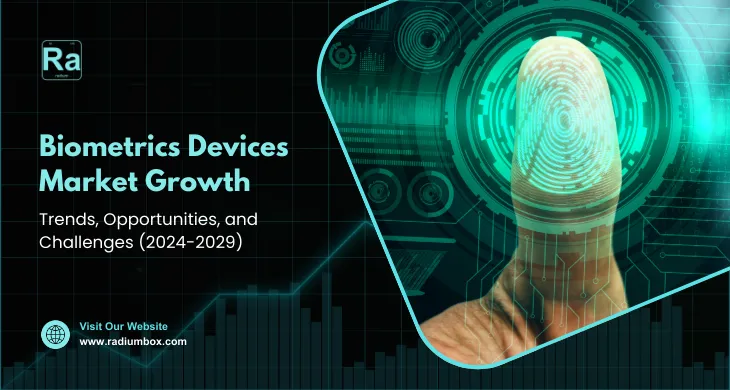
The predicted biometrics devices market size is estimated at USD 47.2 billion and the project will reach USD 84.5 billion by 2029; it is expected to grow at a CAGR of 12.3% from 2024 to 2029.
The expanded adoption of biometrics in tech products has appeared as one of the major growth drivers in the world of biometric system market. The rising demand for security and user comfort has driven this. Nowadays, finger sensors and facial recognition devices are very common in smartphones, laptops and personal devices, thus fueling the demand for biometric systems. The expansion of baas brings huge capacity, especially for SMEs, scalable and cost-efficient solutions without high up-front investment costs. Privacy protection of sensitive biometric information, technically dealing with complex systems happens to be a challenge in case technical know-how is at a premium; these issues play out to major obstacles against mass adoption besides growing data security as well as privacy-breaching concerns. It is thus of utmost importance to create user trust and stimulate the market by ensuring strong security measures and by keeping privacy.
AI Impact on the Biometrics Technology Market
The introduction of AI algorithms like deep learning, neural networks, and machine learning into biometric systems has resulted in high accuracy, speed, efficiency, and adoption. Behaviour recognition has not only introduced a clear distinction based on patterns between a live and dead individual but has also led to vastly differing interdisciplinary approaches in this area. Machine learning techniques like Artificial Neural Networks (ANN), Support Vector Machine (SVM), Deep Neural Networks (DNN), and Genetic Algorithms (GA) play an essential part in the delivery of identification problems.
In the field of Biometrics, while ISO, IEC, NIST, STQC or numerous other bodies are introducing new standards with more security and more AI-based approaches, numerous researchers are trying different AI techniques on methods of biometric identifications.
AI tools & techniques will have an enormous impact on all aspects of our lives. In the biometrics industry, researchers apply AI to boost the accuracy and performance and at the same time design and develop various types of biometric methods like behavior recognition. Governments and organizations must rapidly emerge to respond to new advances and let regulations and ethical rules make public fears smoother. Along with this, AI Software and Hardware security against hackers is primarily ignored and depends on the core system's defences that are attached or implemented.
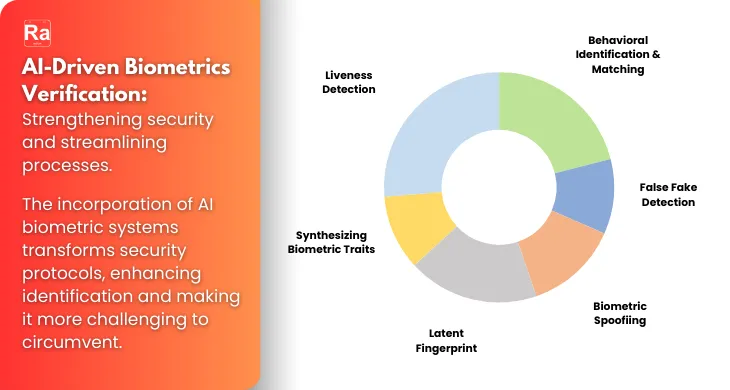
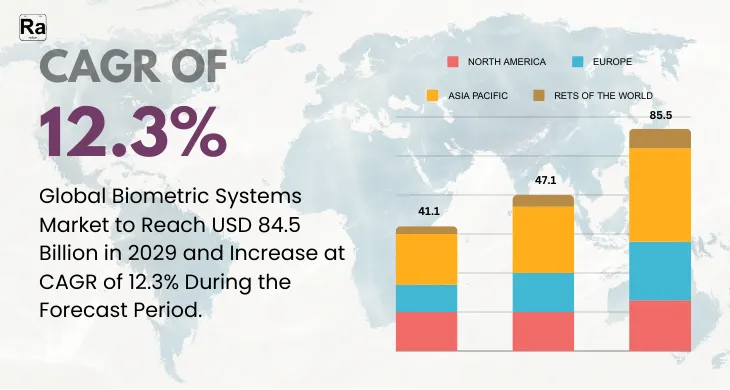
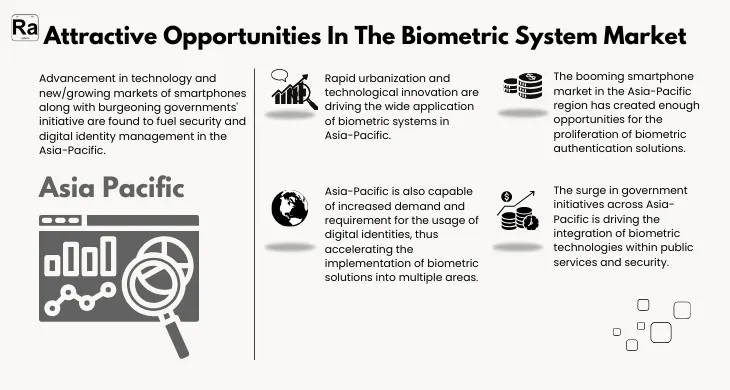
Driver: Increasing adoption rate of biometrics in consumer electronics
High deployment rates in consumer electronics are one of the major growth determinants because they enhance convenience as well as security for the user. From the earliest days of smartphones and tablets to today with laptops, most of the devices have been coupled with biometric features like fingerprint and facial recognition as secure access as well as authentication mode. This has been driven further by the need to have more robust data security as well as a non-shocking experience in use without the shock of current as in the case of passwords. Diffusion and stretching have also spread to other devices, such as smart home appliances and wearables, for secure entry and personalization into consumer technology. In addition, biometric authentication offers safe mobilized transactions as well as online safety with the elimination of the scare of rising cyber threats or identity theft. Biometric sensors and algorithms continue to advance, becoming more accurate and reliable in measurement and hence more friendly to consumers and manufacturers. The demand, therefore, for biometric systems continues to be limitless within this consumer electronics segment. It is through this demand that the consumer electronics segment has significantly impacted the growth of this market.
The high cost related to biometric systems has been one of the major restraints in this market of biometric systems. This includes highly advanced hardware and software, along with all the installation, integration, and maintenance-related expenses in the upfront investment. The latter is quite expensive to many organizations, especially to small and medium-sized enterprises, as the costs of installation are too high, bringing along such technologies. High running costs would be the updating system, storage of data and security measures against sensitive biometric information apart from the above. Another significant reason that explains why the costs are rising is because of the high level of complexity and integration with the existing infrastructure, which requires the highest level of specialized technical skills. Moreover, enormous costs and related tight regulatory standards for compliance, coupled with recurrent audits on data privacy and security, might deter some businesses from investing in biometric systems. Therefore, the money-related obstacles do not let the two trends move fast toward the widespread adoption and integration of biometric technologies into different areas of life.
This would be a big opportunity for the market of biometric systems by scaling up cost-effective solutions for organizations of all sizes. BaaS lets organizations use biometric authentication and identification technologies using cloud-based platforms, minus large upfront investments in hardware and infrastructure, normally required with this model. Biometric systems here offer flexible on-demand access to the new fingerprint, facial, and voice recognition biometrics features according to business needs. Biometric systems here offer flexible on-demand access to the new fingerprint, facial, and voice recognition biometrics features according to business needs. BaaS providers undertake maintenance, updates, and security, putting less technical burden on the client's side. In this manner, one is sure of following all the regulatory standards as it happens to be relatively safer to protect data due to state-of-the-art safety measures in place. With this, BaaS will be pretty attractive to any business that aims to enhance security since the integration is relatively easy compared to previous systems and services are scaled by demand. As more businesses become aware of adopting BaaS, it will be an excellent business to grow biometric system markets dramatically based on this new service model.
Authentication
BaaS is more secure than username/password or PIN-based authentication.
User experience
Access to systems will be more direct using biometrics, such as fingerprint scanning or voice commands.
Cost-efficiency
BaaS minimizes the capital expense of hardware and software that traditional biometric systems incur for development upfront.
Scalability
BaaS can be configured to adapt to changing user volume and system needs.
Fraud prevention
BaaS can enable organizations to combat fraud by rapidly scanning and comparing fingerprints and faces.
Healthcare
BaaS can improve security, ensure proper identification of the patient, and protect personal health information.
Aeroplane
BaaS can use passenger verification of identity without the need for a board pass.
Some of the other applications of BaaS include Employee and customer enrollment, Know-your-customer attempts, Voting booths, and Banking.
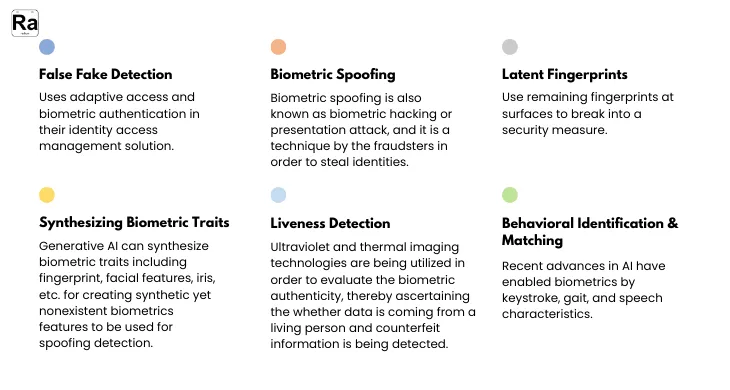
The major challenges that the biometric system market faces are data security and lack of technical know-how. The sensitivities of these systems toward personal information are very high. Thus, they always face cyberattacks and data breaches. For example, the protection of biometric data requires strict security measures, which is impossible for most companies due to the use of technical expertise in installing and maintaining such systems. The more complex biometric technologies are, the greater the requirements for special knowledge for installation, integration, and operation, which complicates their use by less resourceful small enterprises. For one thing, cyber threats continually evolve; thus, security measures must be constantly improved and updated, which calls for more investment in skills and infrastructure related to cybersecurity. Lastly, regulatory compliance - there are just too many strict laws that guard data protection. The combination of these factors thus hinders the widespread adoption of biometric systems as companies weigh the potential risks and technical complications against the gains that can be obtained with the installation of such technologies.
The share of the market for the biometric system is dominated by already established and financially sound companies having considerable experience in the business. Their diversified product portfolio, the development of cutting-edge technologies as well as the developed global sales and marketing network are the key strength tools. The leading players in the market include. Thales, IDEMIA, Mantra Tech, Secunet and Suprema.


The multi-factor authentication segment has the highest growth rate in the market because of increased implementation across industries due to its developed security features. Since it is self-explanatory, multi-factor authentication combines two or more modes of verification that include biometric recognition (fingerprint, facial, or iris) and passwords or tokens. This offers better security in comparison to a single-factor authentication process. Advanced security being critical, its relevance will drive maximum demand in areas like banking and finance, healthcare, and government areas where leakage of information is very undesirable. Given the ever-increasing cyber threats and data breaches, organizations are looking to implement MFA solutions as extra security for systems and data. Moreover, regulatory requirements and the mandate of compliance are pushing organizations to deploy stronger forms of authentication that will further fuel MFA in the biometric system market.
The Software Solution Increasing Demand for a Biometric System during the Forecast Period
It can be anticipated that it will be the highest growth contributor in the market for the forecast period because it has been at the head of the curve in making its biometric hardware more functional and adaptive. Sophisticated software solutions gain access to much more intricate and precise algorithms of biometric recognition, and hence, this trend would accelerate their adoption within applications like mobile devices, security systems, as well as identity verification platforms. There is a shift toward cloud-based and AI-driven technologies within the trend of biometric solutions, which increases demand for software even further. The rationale behind this is that it allows users more scopes for scalability, real-time processing, and improved security features. With that said, there are a lot of advantages surrounding these: that is, their adaptability to other existing systems, their periodic updates with improvements, and good features, suitable for boosting the biometric capabilities of businesses. In this context, the dependence on software-based solutions hints at its criticality and expands the market even faster.
The Consumer electronics vertical reflects the second-highest CAGR in the biometric system market.
In the consumer electronics segment, I expect the software portion of the biometric system market to grow at the fastest rate during the forecast period because it has been driving development in functionality and flexibility in biometric hardware in the recent past. Advanced software solutions enable sophisticated and more accurate algorithms for biometric recognition; therefore, their implementation in various applications, such as mobile devices, security systems, and identity verification platforms, will increase correspondingly. Lastly, biometric solutions are trending toward cloud-based and AI-driven technologies which increase further demand for software. That is because technologies like these give users scalability, real-time processing, and better security features. Other than that, since it can easily be merged with other existing systems, and has regular updates for improvement, and due to these reasons, it will be quite fitting for any business looking to upgrade its biometric capabilities. The dependence on software-driven solutions underlines its key in accelerating market growth in this regard.
Asia Pacific region in the biometric system industry to dominate the market growth
Economically, the fastest growth is in the Asia Pacific, which encompasses vast technological developments and enormous government-sponsored programs, making this region the largest market share in terms of biometric systems. India and China top the board as countries are at the forefront in adopting biometric systems with their national ID programs like Aadhaar, going along with its wide adoption in the banking, healthcare, and security sectors. The high population and high penetration levels of smartphones will fuel the need for biometric technologies incorporated into consumer electronics even further. Also, digital transformation and smart city projects are gaining importance in various industries across the Asia-Pacific region, which is further driving demand for biometric solutions. Other factors that have put the region in such a dominant position regarding market interest in the biometric system include supportive government policies and huge investments in security infrastructure.
|
Geographies covered |
North America, Europe, Asia Pacific, and Rest of the world (RoW) |
|
Companies covered |
Precision, Secugen, Iritech inc, Neuro Technology, Startek, Bioenable, Thales, Idemia, Mantra, Secunet, Suprema. |
Biometric System Market Highlights
The study categorizes the biometric system market size based on the following segments:
|
Segment |
Subsegment |
|
By Authentication Type |
|
|
By Offering |
|
|
By Mobility |
|
|
By Type |
|
|
By Deployment Mode |
|
|
By Vertical |
|
|
By Region |
|
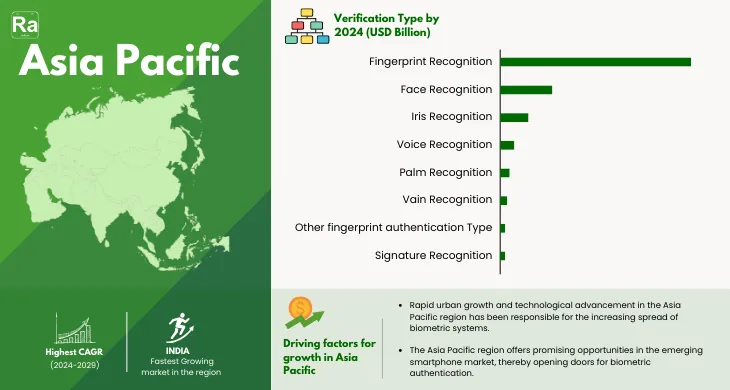
Recent Developments
IDEMIA released its new facial recognition access control solution, VisionPass SP, in January 2024 which guarantees precise and unbiased match, within a second, even in the presence of diverse lighting conditions. The compact eco-friendly device brings together high-performance AI and facial recognition algorithms with robust security measures against cyber attacks. VisionPass SP maintains a superior standard of security standards added to the richness of user experience.
Japan's Immigration Services Agency and Customs have awarded a contract to NEC Corporation to install joint Immigration & Customs Declaration KIOSKs at Haneda Airport Terminal 2. The KIOSKs will be designed to streamline procedures based on advanced registered information. They will make things easier with increased international travellers going through Japan as the country aims to see 60 million visitors by 2030.
In October 2023, Thales teamed up with SoyYo, leading the digital identity provider for companies in Colombia. The company will extend FIDO2 passkeys from the success of passwordless authentication in Colombia, security with user experience for millions. It will also enhance the biometric solutions of Thales by securing passwordless access through either biometrics or device codes.
Major driving factors for the implementation of biometric systems include the growing adoption of biometric technology in consumer electronics for authentication and identification and the rising focus on enhancing governance and welfare delivery with biometrics. The growth of this market is likely to be fueled through collaborative strategies among participants in the supply chain for biometric systems.
Size-wise, the market leader should come from the Asia Pacific region. More importantly, it should be an area where there are extensive growth opportunities for biometric authentication solutions, driven by the rising adoption of smartphones.
Some of the high number contributors in the market are Precision, Secugen, Iritech inc, Neuro Technology, Startek, Bioenable, Thales, Idemia, Mantra, Secunet, and Suprema. Apart from that, these companies pursue several strategies which include the launch of new products and developments, collaborations, partnerships, and acquisitions. These methods make these companies superior to other companies in the market.
It is advancing technology that has made methods of authentication even more accurate and efficient, with better fingerprint, facial, and iris recognition technologies. Further innovations in AI integration and improved sensors only make for more reliability and scalability in the offerings of biometric solutions.
The market of the global biometric system has reached USD 47.2 billion in 2024 and is expected to reach USD 84.5 billion, at a CAGR of 12.3% during the forecast period.
The market size for the facial recognition market was estimated to be about five billion U.S. dollars in 2022. It continues to grow up to the year 2032, with an estimated value of 19.3 billion U.S. dollars. Facial recognition technology is an artificial intelligence software tool that uses a person's facial features to identify them.
Some of the most popular biometric security methods are fingerprint and iris scanning. Apart from these, facial identification and vein pattern recognition in fingers and palms are also being developed as increasingly powerful tools.
According to a new survey by the online IT community Spiceworks on the adoption and security of biometric authentication technology, 62% of organizations use biometric authentication technology. In addition, 24 per cent of respondents claimed that they would make use of this technology within the next two years.
Biometric authentication in the form of multifarious methods is being widely adopted by business enterprises, including fingerprinting and face recognition, voice authentication, and iris scanning, to enhance security and convenience during payment. These technologies ensure both secure forms of user identity verification and enhance the user experience while preventing fraudulent transactions.
The Aadhaar is India's largest biometric system, which issues a unique number based on biometric and demographic data for over 1.4 billion residents.
While the use of biometric methods by information technology, finance, and the government to authenticate users has the most growth, retail and software services are not behind. Different company activities targeted by biometric use vary greatly.
As it stands now, biometric systems can uniquely associate an individual with that identity-which means that fraudsters can have a hard time impersonating others. So the future of biometrics appears to be bright, especially when talking about identification verification.
As stated above, fingerprint scans are correct at least 98% of the time at worst; they peak at high points at 99.91% accuracy.